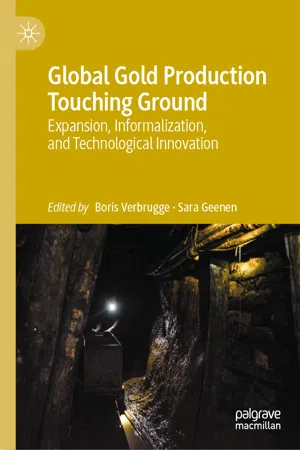1.1 A Dual Gold Mining Economy?
The Syama mine, located 300km southeast of Mali’s capital Bamako, has total reserves of 2.9 million ounces of gold. Work on the deep drilling program at the mine began in late 2015, ensuring the new, low levels of the mine are designed with automation in mind. (…) Throughout the mine there will be a fibre-optic network, ensuring that the autonomous haulage trucks and other elements are in constant contact with the control centres above ground. (…) The advantages of automating a mine are clear, as the technology increases efficiency and improves safety. (Mining Technology 2018)
The gold rush is only four months old in Nathenje, Malawi, but already there are thousands of prospectors digging, shoveling and sifting soil in the age-old search for a nugget that will transform their lives. Using rudimentary picks and shovels, villagers from the nearby settlements of Lumwira and Dzondi have been joined by other Malawians from across the country, more experienced in gold panning. An informal system of bosses and employees has also sprung up, alongside a makeshift collection of plastic shelters offering basic accommodation. (AFP 2018)
In an operation that lasted a couple of days and that involved four airplanes, police officials, forest rangers and the National Guard, Brazilian authorities dismantled a number of open-pit gold and cassiterite mines operating illegally in the heart of the Amazon. (…) A $200,000-shotgun, eight hydraulic excavators, four motor pumps and other equipment were seized and destroyed. (…) According to official information, illegal mining in the remote area generates profits of at least $120,000 per month. (Leotaud 2018)
Artisanal and small-scale gold mining | Industrial gold mining | |
|---|---|---|
Main actors | Poor (rural) communities | Mining companies |
Driving force | Poverty/subsistence | Profit/accumulation |
Type of operations | Rudimentary gold panning and tunneling activities | Large open-pit and underground mining operations |
Technology use | Minimal use of technology | Extensive use of modern technology |
Factor intensity | Labor-intensive | Capital-intensive |
Regulatory situation | Informal—criminalized by state | Formal—protected by state |
1.2 Diversity and Connectivity
Gran Colombia’s chief executive officer, Lombardo Paredes, said the company would now incorporate additional small mining collectives into its contract mining model. (…) Currently, over 2,500 informal miners operate within the company’s title. Over the next few months, the company will negotiate specific operating contracts with each of the mining collectives that have interests in Gran Colombia’s property. (Jamasmie 2017)
Traditionally –even in a formalized supply chain – small local traders buy from artisanal miners and sell on to big national exporte...
